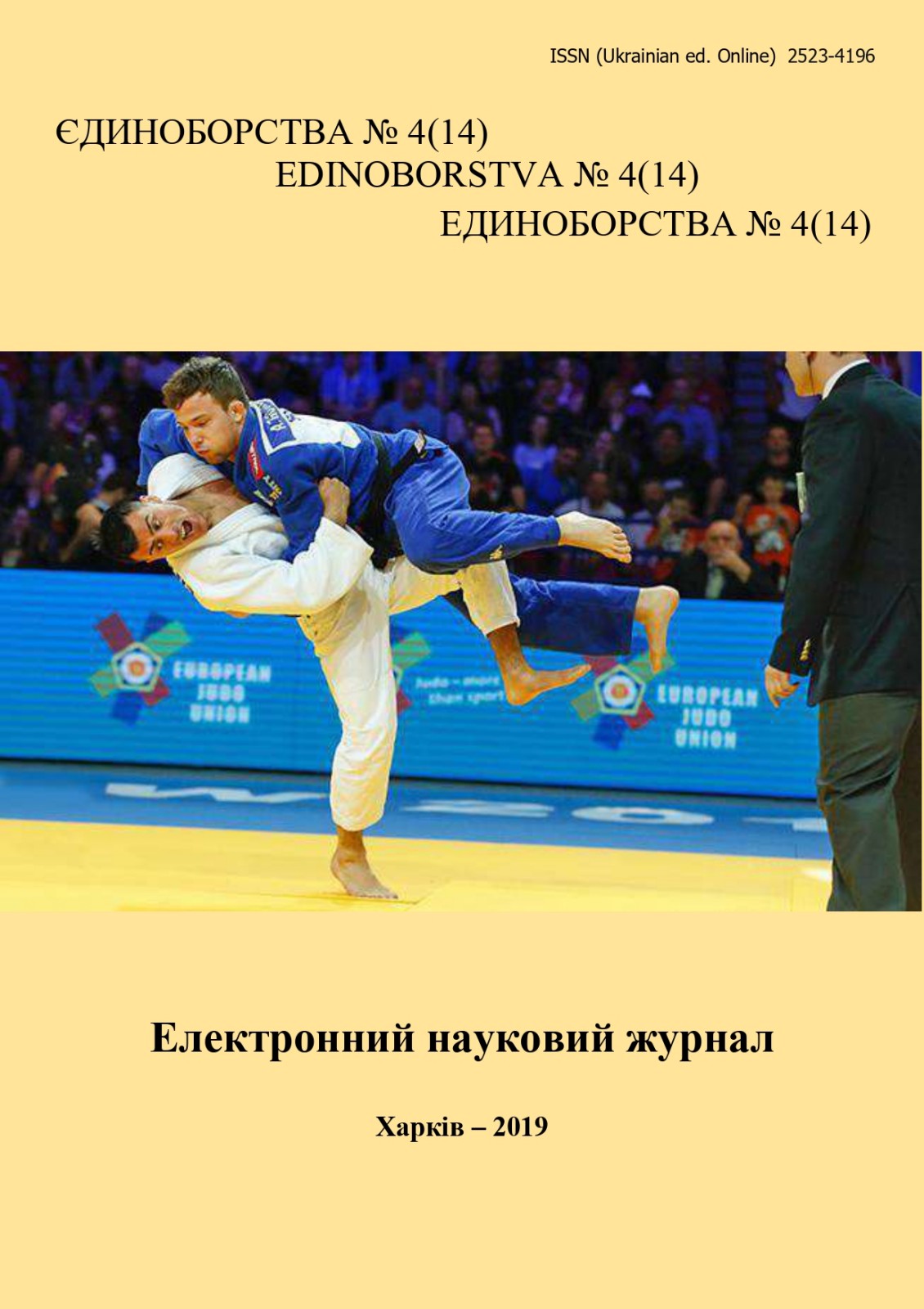The use of exercises with fitball in teaching the technique of throwing in judo
DOI:
https://doi.org/10.15391/ed.2019-4.13Keywords:
fitball, means, reception, throws, technique, phases, elements, training, expertsAbstract
Purpose: to optimize the process of training in judo throws using exercises with fitball. Material and methods. In the course of pedagogical research, the method of expert assessments was used. Experts evaluated the throwing technique of the studied athletes (n=30). The age of the studied athletes is 10-11 years. Research methods: theoretical analysis and generalization of literary sources, pedagogical observations, expert assessment method, methods of mathematical statistics. Results. All athletes were divided into control (n=15) and experimental (n=15) groups. A feature of the educational process in the experimental group was the use of exercises with fitballs aimed at studying the technique of throws. Experts evaluated the fidelity of such technical indicators: unbalancing an opponent; work and position of arms, legs and torso; control of the opponent during the throw and touchdown. Considering the results of the method of expert assessments among judoists of the experimental group at the beginning and at the end of the study, we can say that the average score in terms of indicators increased significantly and the growth was significant (<0,05). An improvement in the results of the experimental group over the control one is also observed in the sasae-tsuri-komi-aishi, but they are not statistically significant (t=0,68; p>0,05). This can be explained by the focus of the training process of the control group on the study of this normative throw. The analysis also showed that the performance of athletes in the control group has a positive dynamics but not as pronounced as that of the athletes of the experimental group and, accordingly, statistically significant changes in only the sasae-tsuri-komi-aishi (t=2,51; p<0,05). Obviously, the group that used the presented fitball exercises to study the shots has significantly better results. Conclusions. Based on the data of athletes obtained at the beginning and end of the pedagogical experiment, it can be noted that each judoka in the control and experimental groups experienced an increase in the level of indicators, but among the athletes of the experimental group they are statistically significant. The best growth result among the athletes of the experimental group was the uchi-mata (t=3,75; p<0,05) and the о-uchi-gari (t=2,83; p<0,05) in the throw.
References
Алексєєв, А. Ф., Ананченко, К. В., & Бойченко, Н. В. (2014). Теорія та методика викладання дзюдо та самбо: навч. посіб. для студенів 3 курсу (за кредитно-модульною системою). ХДАФК, Xарків.
Ананченко, К. В., & Середа, В. В. (2008). «Технічна підготовка юних дзюдоїстів на основі аналізу модельних характеристик». Teorìâ ta Metodika Fìzičnogo Vihovannâ, (8), 47-49.
Бойченко, Н. В. (2007). «Пути повышения эффективности тренировочного процесса в восточных единоборствах». Физическое воспитание студентов творческих специальностей, 2, 148-150.
Бойченко, Н. В., & Чоботько, М. А. (2019). «Оптимізація навчання техніки дзюдо за допомогою вправ з фітболом». Єдиноборства, 13-20.
Васильков, А. А. (2008). Теория и методика спорта. Феникс, Ростов н/Д.
Верітов, О., Макарова, Е., & Гузій, О. (2012). «Підходи щодо профілактики і корекції порушень опорно-рухового апарату дітей, які активно займаються спортивними одноборствами». Спортивна наука України: електронне наук, фах. вид, (4), 48.
Ермаков, С. С., Тропин, Ю. Н., & Бойченко, Н. В. (2016). «Специальная физическая подготовка квалифицированных борцов». Единоборства, 20-22.
Камаєв, О. І., Тропін, Ю. М., & Арнаут, В. Ю. (2019). «Біомеханічний аналіз виконання технічних дій у спортивній боротьбі». Проблеми і перспективи розвитку спортивних ігор і єдиноборств у вищих навчальних закладах, 1, 32-35.
Мельник, В. В., & Дяченко, А. А. (2016). Вплив ігрових вправ з фітболами на розвиток швидкісно-силових здібностей дзюдоїстів 6-7 років. Київ.
Никитин, С. Н. (2005). «Особенности управления двигательными действиями в спортивной борьбе». Вестник Балтийской педагогической академии, Вып. 62, 61-67.
Пакулін, С. Л. (2015). «Алгоритм формування коронного прийому дзюдоїста-ветерана». Міжнародна науково-практична конференція «Фізична культура, спорт та здоров'я», 79-81.
Перебейнос, В. Б., & Ананченко, К. В. (2012). «Формирование оптимального технического арсенала дзюдоистов-ветеранов». Слобожанський науково-спортивний вісник, (2), 100-103.
Платонов, В. Н. (2015). Система подготовки спортсменов в олимпийском спорте. Общая те- ория и ее практические приложения : учебник [для тренеров] : 2 кн. Олимп. лит., Киев.
Тропин, Ю. Н., & Бойченко, Н. В. (2017). «Содержание различных сторон подготовки борцов». Единоборства, 79-83.
Чоботько М. А. (2018). «Особенности методики обучения дзюдоистов новичков» Единоборства, 75-78.
Шахмурадов, Ю. А. (2011). Вольная борьба: Научно-методические основы многолетней подготовки борцов. Высшая школа, Москва.
Шулика, Ю. А., Коблев, Я. К., Невзоров, В. М., & Схаляхо, Ю. М. (2006). Дзюдо. Система и борьба. Феникс, Москва.
Zhumakulov, Z. P. (2017). «Education Technology of Primary Training Sport Wrestling». Eastern European Scientific Journal, 5, 29-35.













